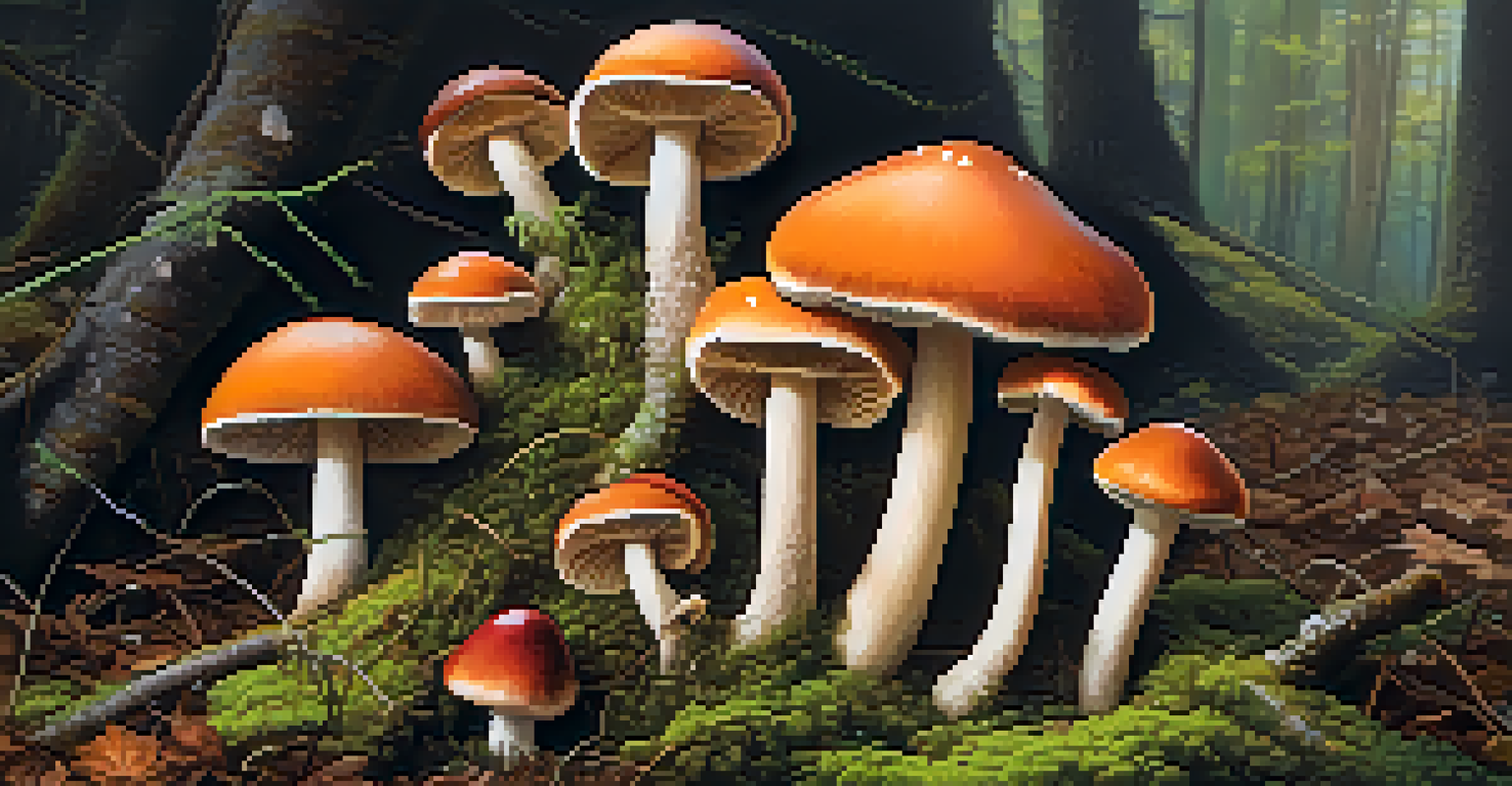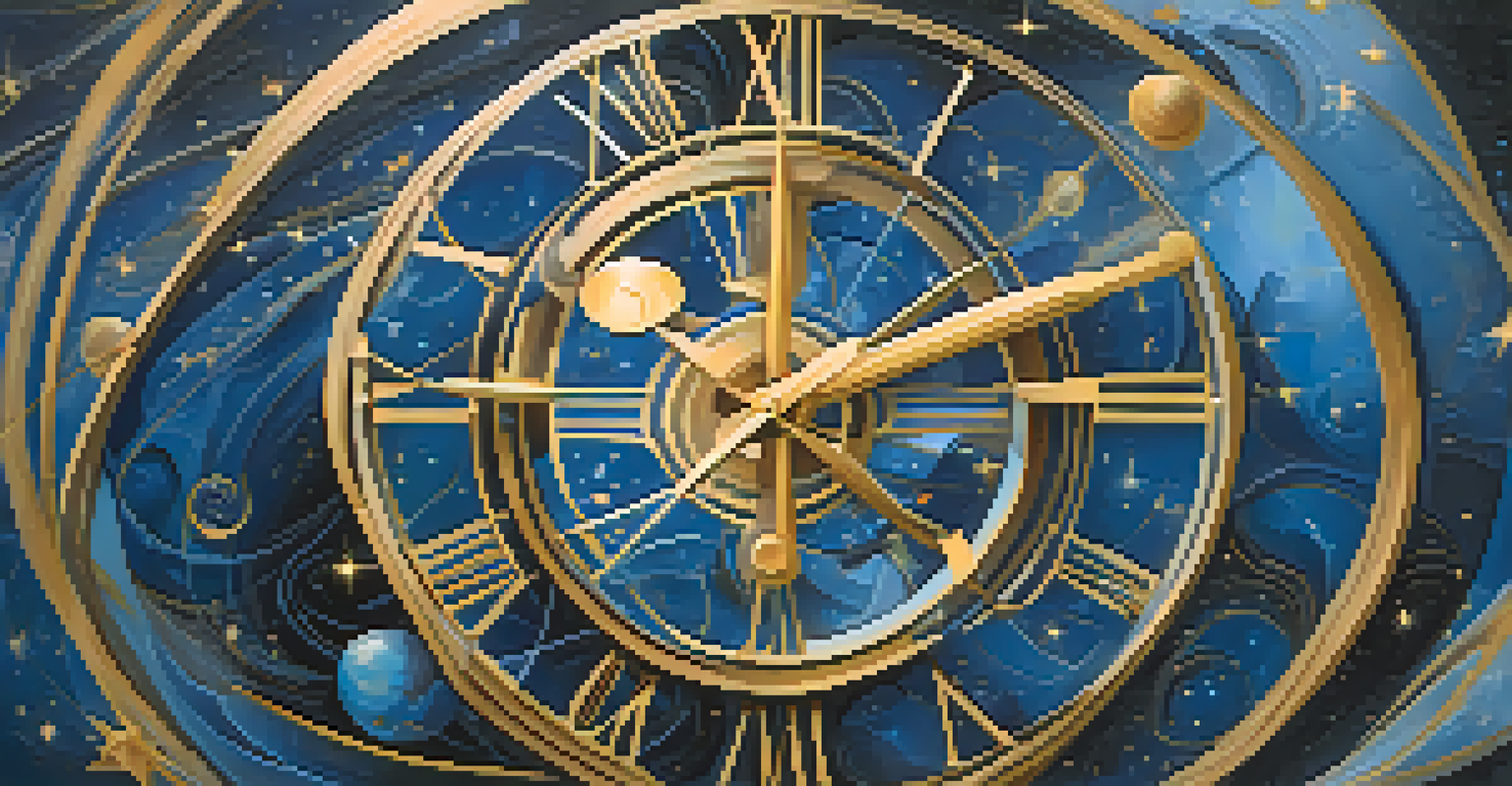The Intersection of Entheogens and the Concept of Time

Understanding Entheogens and Their Cultural Significance
Entheogens are substances that can induce altered states of consciousness, often used in spiritual or religious contexts. These natural compounds, like psilocybin in mushrooms or ayahuasca, have been utilized for centuries across various cultures to foster a deeper connection with the universe. Their significance goes beyond mere recreational use, as they often play a crucial role in rites of passage and healing ceremonies.
The mind is everything. What you think you become.
In many indigenous cultures, these substances are viewed as sacred tools for understanding the self and the cosmos. They offer users a chance to explore their consciousness, which can lead to profound insights about existence. This cultural backdrop is vital for understanding how entheogens might influence perceptions of time.
As we dive deeper into this exploration, it’s essential to recognize that the experiences induced by these substances can reshape our understanding of reality, including the concept of time itself. The intersection of these two ideas is where the magic truly lies, inviting us to rethink the linearity of our everyday experiences.
The Nature of Time: A Philosophical Perspective
Time is often perceived as a linear progression, moving from past to present to future. However, many philosophers argue that this view is overly simplistic, suggesting that time may be more fluid and subjective. This philosophical debate invites us to consider how our experiences, particularly those altered by entheogens, can challenge our conventional understanding of time.

For instance, during a psychedelic experience, individuals frequently report feelings of timelessness or a warped sense of time. Moments can stretch into infinity or condense into fleeting seconds, leading to a profound sense of connection with the universe. This experience raises intriguing questions about the nature of time and whether it is merely a construct of human perception.
Entheogens Alter Time Perception
Users of entheogens often experience a non-linear perception of time, leading to profound insights and emotional healing.
Additionally, the idea that time is not strictly linear opens up new avenues for understanding our existence and experiences. By exploring these concepts, we can better appreciate how entheogens might help us transcend traditional notions of time, allowing for deeper introspection and connection.
Altered Perceptions of Time Under Entheogens
Users of entheogens often describe their experiences as a journey through time, where past, present, and future intertwine. This altered perception can result in vivid recollections of past events or anticipatory visions of the future. Such experiences can evoke a sense of nostalgia or foreboding, transforming how individuals relate to their life narratives.
Time is a created thing. To say 'I don't have time,' is like saying, 'I don't want to.'
For example, someone under the influence of psilocybin might find themselves reflecting on childhood memories with a clarity they hadn’t experienced in years. This reflective state can lead to emotional healing, as unresolved issues from the past surface and are confronted. In this sense, entheogens serve as a bridge to time, allowing users to revisit and recontextualize significant life events.
Moreover, this distortion of time can also inspire creativity and innovation. Artists, writers, and musicians often cite moments of profound insight during psychedelic experiences, where time becomes a canvas for ideas to flow freely. This creative potential further emphasizes the transformative power of entheogens in reshaping our understanding of time.
Scientific Insights: The Neuroscience of Time Perception
Recent studies in neuroscience have begun to unravel how entheogens affect our brains, particularly in relation to time perception. Research indicates that these substances can alter neural pathways and enhance connectivity between different regions of the brain. This heightened connectivity may contribute to the experience of time dilation or contraction during psychedelic experiences.
For instance, brain imaging studies have shown that users of entheogens exhibit increased activity in areas associated with memory and emotional regulation. This suggests that the brain is not merely processing time in a linear fashion but is instead integrating multiple temporal experiences simultaneously. Understanding these mechanisms can shed light on why users report such profound alterations in their perception of time.
Cultural Views on Time Differ
Indigenous cultures perceive time as cyclical and interconnected, contrasting with Western linear concepts and enhancing the use of entheogens in spiritual practices.
Additionally, these findings pave the way for therapeutic applications, particularly in treating conditions like PTSD or anxiety. By helping individuals reframe their relationship with time and past trauma, entheogens might offer a unique approach to mental health treatment, illustrating the powerful intersection between neuroscience and our understanding of time.
Time and Spiritual Experiences with Entheogens
Many users report that their experiences with entheogens lead to profound spiritual insights, often accompanied by a non-linear perception of time. This sense of timelessness can foster feelings of unity with the universe or a connection to something greater than oneself. Such experiences can be deeply transformative, influencing one’s beliefs and understanding of existence.
For instance, during a ceremony with ayahuasca, participants often describe feeling as though they are traversing multiple lifetimes or experiencing the collective consciousness of humanity. This perception challenges the conventional notion of time as a series of isolated events and instead presents it as a fluid continuum. Such insights can lead to lasting changes in values and priorities, emphasizing the importance of living in the present moment.
Moreover, these spiritual experiences can be a catalyst for personal growth and healing. By confronting existential questions and fears during these journeys, individuals may emerge with a renewed sense of purpose and direction, reshaping their relationship with time and their life trajectory.
Cultural Perspectives: Time in Indigenous Practices
Indigenous cultures often possess a unique understanding of time that contrasts sharply with Western linear concepts. Many indigenous philosophies view time as cyclical, with a focus on the interconnectedness of past, present, and future. This perspective is reflected in their spiritual practices, which frequently involve the use of entheogens to access different temporal states.
For instance, shamans in various cultures utilize entheogens during rituals to connect with ancestral spirits or the natural world. This practice reinforces the idea that time is not just a personal experience but a shared journey among all living beings. Such practices highlight the importance of honoring the past while remaining present and mindful in the moment.
Science Meets Spirituality
The growing research on entheogens bridges scientific and spiritual perspectives, offering potential therapeutic applications and deeper understanding of consciousness.
By examining these cultural perspectives, we can gain valuable insights into how entheogens have historically shaped human relationships with time. This understanding fosters appreciation for diverse worldviews and encourages a more holistic approach to our own experiences of time and existence.
The Future: Bridging Science and Spirituality
As research into entheogens continues to expand, we find ourselves at a fascinating crossroads where science meets spirituality. This intersection offers exciting possibilities for understanding the complexities of human consciousness and the nature of time. By integrating scientific insights with personal and cultural experiences, we can cultivate a richer understanding of our existence.
Future studies could explore how entheogens can be used as tools for personal development, mental health, and spiritual growth. As we learn more about their effects on time perception, we may also uncover new therapeutic applications that help individuals navigate their lives more meaningfully. This potential for positive impact underscores the importance of fostering a respectful dialogue between science and spirituality.

Ultimately, the exploration of entheogens and time encourages us to rethink our relationship with existence. By embracing both scientific inquiry and spiritual experiences, we can gain a deeper understanding of ourselves and our place in the universe, paving the way for future generations to explore these profound intersections.